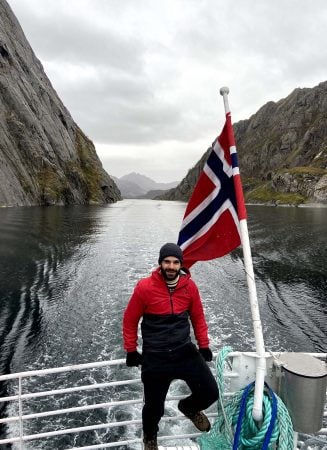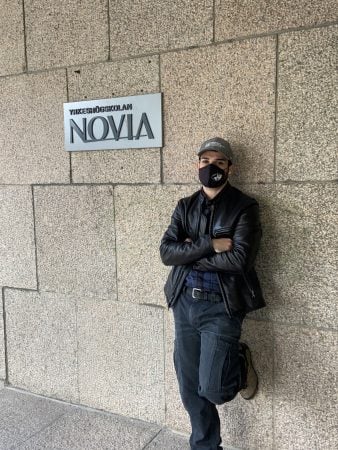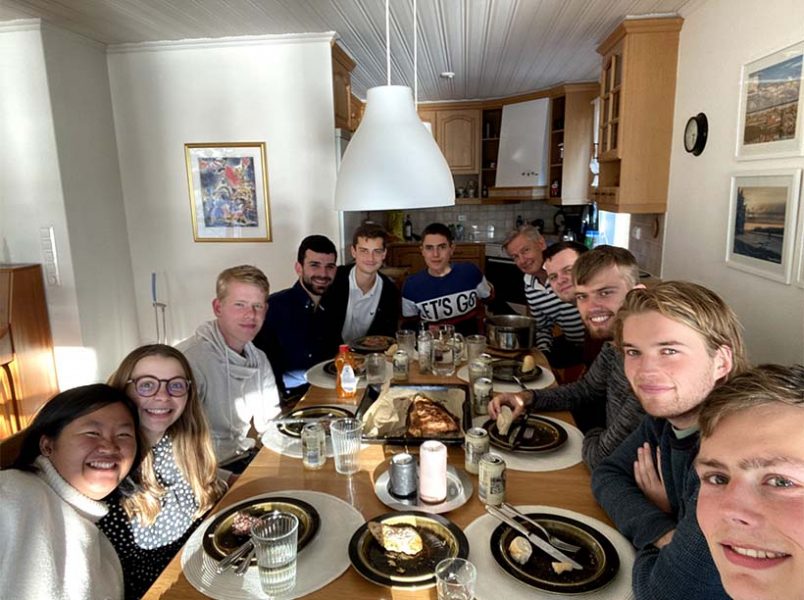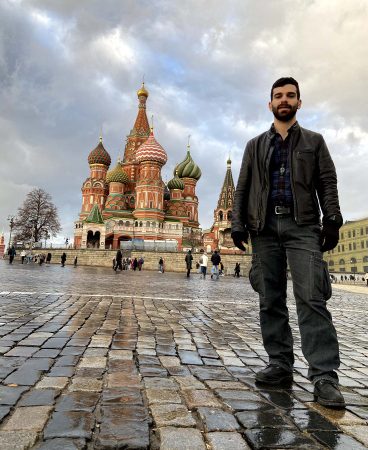“Being present and living in the now” is the motto Estefanio Kesto lives by, and his goals are ever changing, expanding, and adapting as life takes him in new directions.
A bit about Estefanio Kesto

Estefanio Kesto is an electrical engineering student at Michigan Tech with a focus on Photonics—the study of light detection, manipulation, and generation. He’s involved in SPIE, the International Society for Optics and Photonics, as well as performing experimental research under the guidance of Professor Miguel Levy in the Department of Physics. Kesto is also involved in Tau Beta Pi, the Engineering Honor Society and Eta Kappa Nu, the honor society of IEEE. He describes himself as an outdoorsman and an avid cyclist, as well. “If you approach me with any activities that involve the outdoors, then you can count me in!”
How did you get interested in Studying Abroad?
Many engineering students don’t seem to take the opportunity to study abroad. This is generally due to the misconception among them that transferring the course credits can be very involved and difficult. Additionally, many students are intimidated by the financial aspects. I also hesitated due to both of these things, which postponed my own study abroad endeavor. I eventually attended a meeting hosted by Vienna Leonarduzzi, then Michigan Tech’s study abroad coordinator. She discussed many options to overcome these obstacles.
The process of studying abroad looks hefty from the outside, but once you get more involved, you quickly learn that there are not only many options for engineering coursework to transfer into your degree program, but also options for merit and need-based scholarships to alleviate the potential financial burden.
How did you end up funding your trip?
In my case, I was privileged to be supported by the Benjamin A. Gilman International Scholarship. The Gilman scholarship gives underrepresented individuals higher priority when it comes to financial support. As it turns out, engineering students are considered to be underrepresented when it comes to studying abroad! Use this fact to your advantage when writing scholarship essays for funding. Additionally, there may be university-wide study abroad scholarships available to relieve some of the financial burden. In any case, be sure to discuss your funding options with the study abroad coordinator at Michigan Tech before jumping to conclusions. For me, it was the Gilman program that truly enabled me to study abroad. I even discovered post-study abroad incentives that come with being a Gilman alum!

I also discovered that the process of transferring courses taken abroad is significantly easier when done earlier in your degree program. So, my recommendation would be to study abroad as early in your degree program as possible! Studying abroad, say, as a freshman or sophomore, gives you more options in choosing your host country, too. This is because general education, free electives, and lower-level engineering courses are much easier to be replaced with study abroad courses, compared to senior level classes.
This was not the case for me, though. I first began to search for study abroad programs that would satisfy course requirements in the final year of my undergraduate studies. As a result, it quickly became discouraging—until Vienna informed me that courses offered through the European Project Semester (EPS) program can be used to satisfy the engineering senior design requirements for my electrical engineering degree. So, if you find yourself in my shoes, find a European Project Semester program in a host country of your liking and jump on it!
Where did you study and live?
I lived in the town of Vaasa, which is on the southwest coast of Finland, located on the Gulf of Bothnia. Vaasa was not what I was expecting. It turned out to be one of the largest Swedish speaking towns in Finland (the second language in Finland is Swedish). Only 6 percent of the Finnish population speaks Swedish, but 50 percent of the people in Vaasa speak Swedish. This caught me off guard, as I was expecting a full Finnish-speaking town.
Why did you choose Finland?
There is a strong Finnish heritage presence in the Keweenaw, where Michigan Tech is located. It inspired me to want to better understand who the Finnish people are, and in my opinion, there’s no better way to do that than fully immersing yourself in the culture of their home country, Finland!

What was your academic experience like in Finland?
European Project Semester (EPS) is a collaborative learning program for undergraduate students studying any of the sciences, technology, engineering, and mathematics (STEM). There are 19 host institutions across 13 countries that make up this program today. It’s project-based, with projects often sponsored by companies in industry. This gives students the opportunity to apply their theoretical studies in the real working world.
Students work in multinational, interdisciplinary teams of three to six students. At the beginning of the semester, EPS presents the engineering projects, and students choose their preferences. My project relied heavily on the internet of things (IoT), automation, and other aspects of software/mechanical/electrical engineering.
The main objective of my collaborative project was to develop an IoT platform to facilitate the integration of different-branded smart devices in an automated living environment for disabled or elderly individuals, all within one intuitive user-interface. For example, products coming from Samsung, LG, Nest, and other electronic brands all have their own app. Our task was to integrate them all into one user-friendly app to control this automated living environment. It turns out the IoT could easily realize this problem. In addition to successfully creating an intuitive user-interface, my team and I further innovated the automated living environment by taking devices which were not considered ‘smart’ devices (i.e., had no connectivity capability) and turned them into ‘smart’ devices with the help of an ESP32 which is a microcontroller with Wi-Fi capabilities.
The experience was absolutely phenomenal. The university I attended, Yrkeshögskolan Novia (Novia University of Applied Sciences), and the faculty who guided my team, went above and beyond in providing my team with the resources and guidance to accomplish the task at hand. Additionally, working in a multi-cultural and interdisciplinary team of engineers allowed me to better understand how different cultures approach academia, work, and day-to-day life.

What was the best part of the experience?
Living in a housing accommodation full of exchange students from all over the world! This did have its pros and cons, though. The biggest pro was the gaining of mutual cultural understanding from a diverse cohort of exchange students. The biggest con was that there was only one Finnish student, and I had been searching for native Finnish students to ‘adopt’ me into their cultural traditions. The ‘adoption’ was quite difficult considering I wasn’t able to socialize with Finnish students in my everyday life.
What was the most challenging part of the experience?
If you think it’s dark and cold here in the Keweenaw, you’re mistaken, because Finland beats the Keweenaw in that respect. The cold wasn’t so challenging, but the lack of winter daylight, at least in comparison to the Keweenaw, was the most challenging thing for me. The sun would start to rise around 10am and set by 4pm. I found it tough to cope. It’s difficult for me to wrap my head around how Finland has consecutively been rated the happiest country in the world in spite of the lack of daylight they receive.
Did you visit any other cities or countries?
When you study abroad, you shouldn’t stay in your college town for the entire duration of your studies. This would make it very difficult to gain sufficient mutual understanding of your host culture. Luckily, my international coordinator at Yrkeshögskolan Novia encouraged exchange students to travel with the Erasmus Student Network (ESN) as much as possible. ESN subsidizes travels for exchange students around the EU, which makes the cost of traveling significantly cheaper than traveling on your own. I visited Oulu, Tampere, Turku, and Helsinki which are all cities within Finland. Outside of Finland I visited Norway, Sweden, Germany, Austria, and France. Additionally, Professor Levy organized an opportunity for me to visit the Russian Quantum Center in the Skolkovo district of Moscow, where I was able to meet some of our collaborators and observe their experimental techniques.
When will you graduate, and what are your plans for the future?

Life changes, and you must be present in the now to adapt. Being present, and in the moment, allows you to adjust your professional goals accordingly. A strict, long-term professional goal that isn’t malleable can quickly deteriorate, due to challenges life throws at you. In turn, not meeting that goal within your perceived and specified timeframe can result in self-discouragement.
The motto that best describes and dictates where I find myself in life is ‘being present and living in the now.’ In other words, I don’t have a strict long-term goal in regard to where I want to be in my professional life at any certain time. My professional goals change and will change in proportion to what’s happening now.
I do have an idea of where I want to be. I’d like to be working as a professor, instructing the next generation of scientists and engineers—or I’d like to work as a research scientist, making contributions that impact our society even more broadly. This is by no means a strict goal that I’m holding over my head.
As for my post-baccalaureate plans, I’ve been admitted into a doctoral program in the University of Michigan’s Department of Physics, where I will be continuing my research studies within the optical sciences.